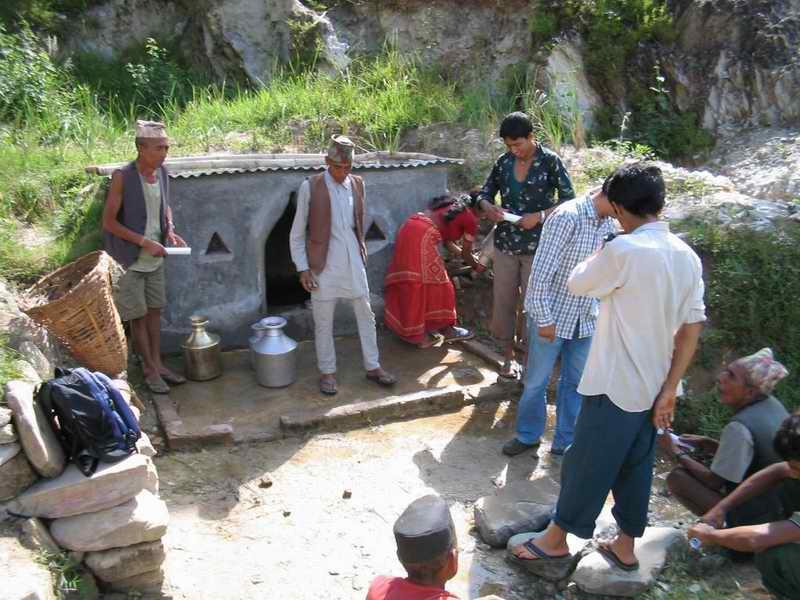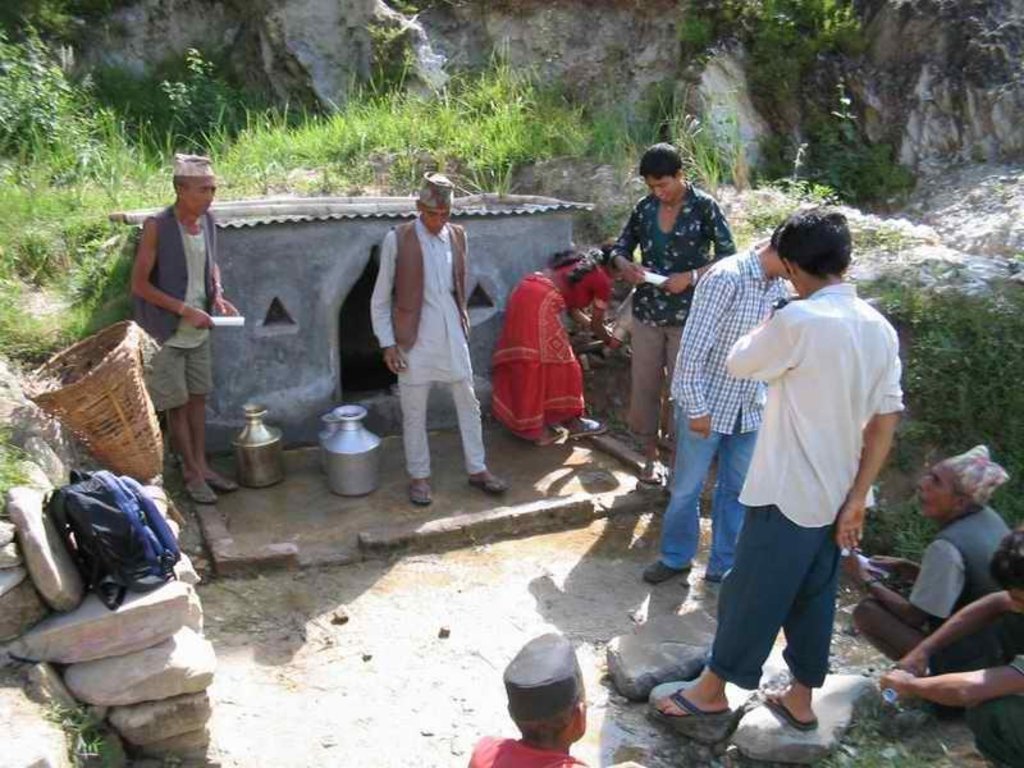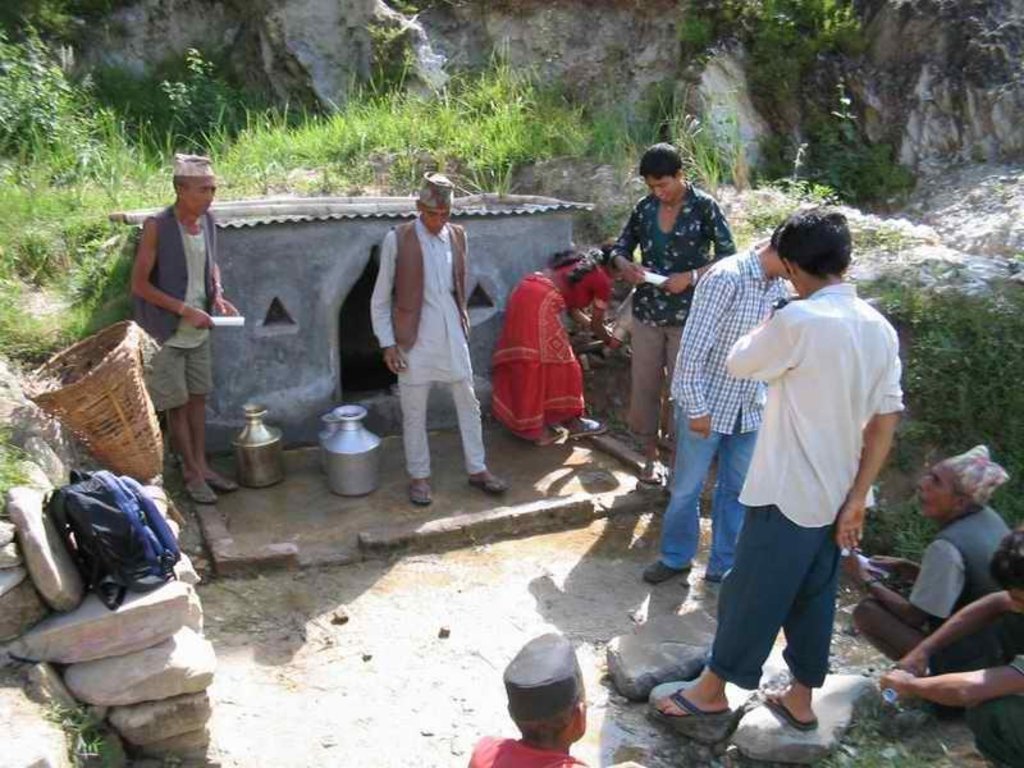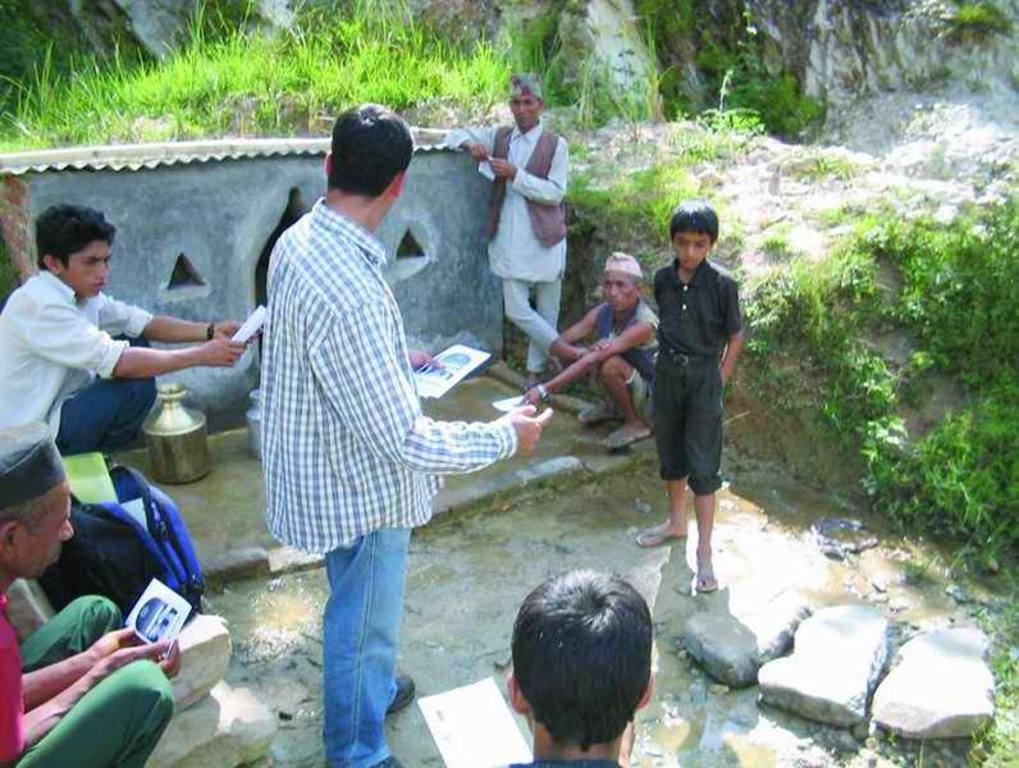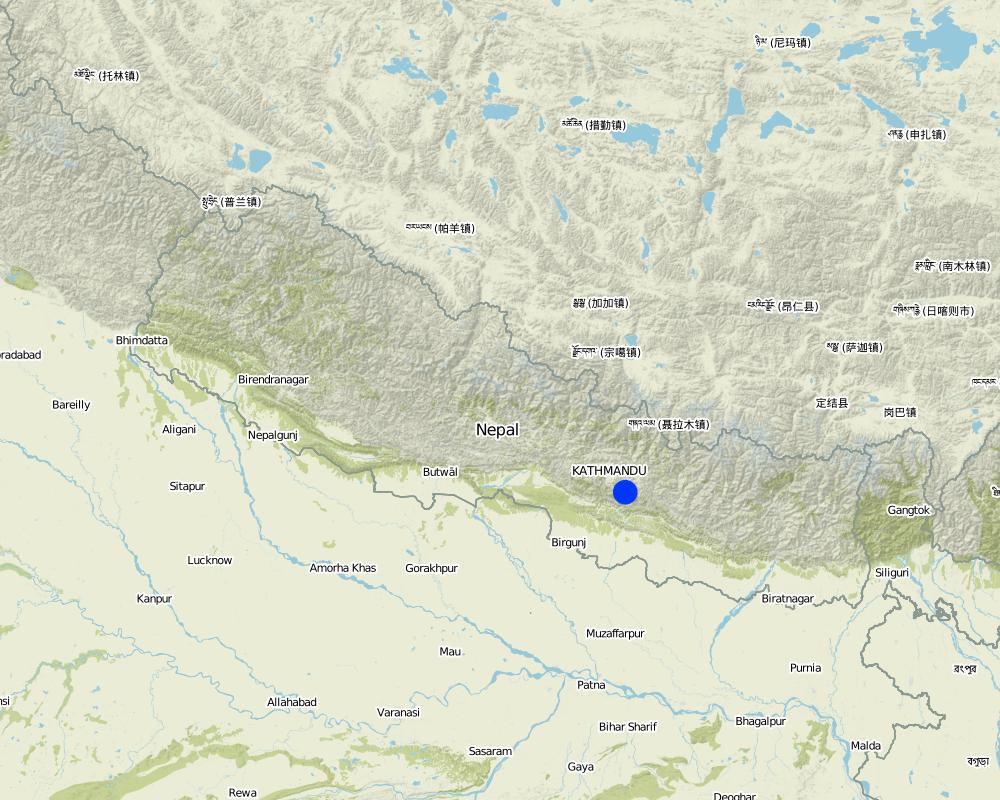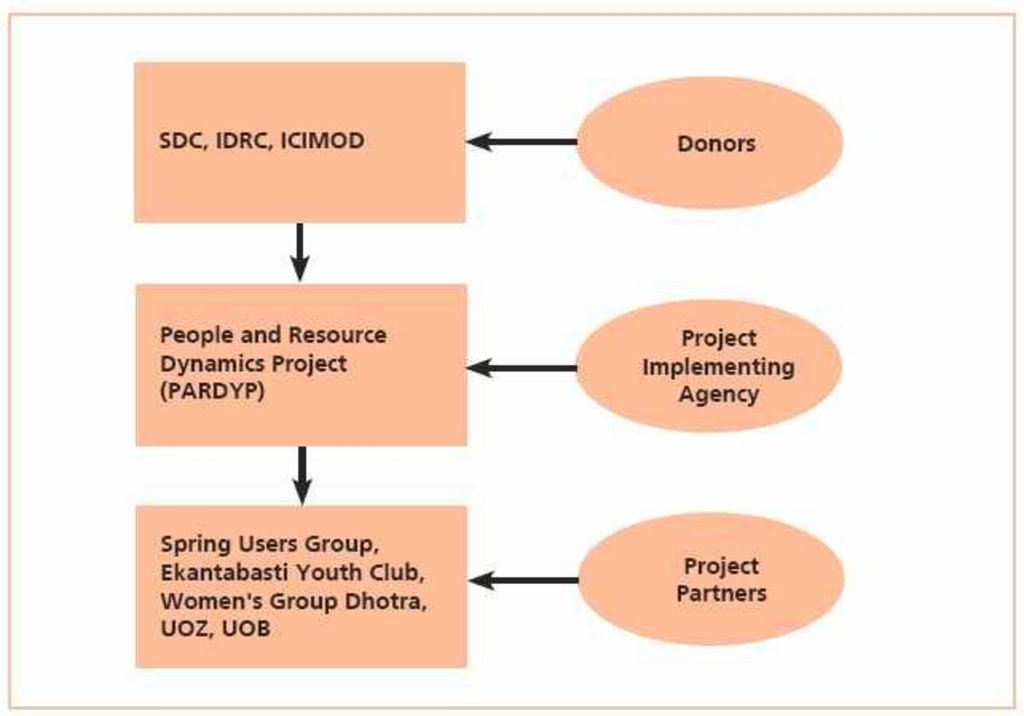Community efforts for improving drinking water quality [尼泊尔]
- 创建:
- 更新:
- 编制者: Madhav Dhakal
- 编辑者: –
- 审查者: Fabian Ottiger
Piune paani ko gunastar sudhar ka lagi samudayik prayas
approaches_2352 - 尼泊尔
查看章节
全部展开 全部收起1. 一般信息
1.2 参与方法评估和文件编制的资源人员和机构的联系方式
SLM专业人员:
Isabelle Provodoli
himcat@icimod.org
International Centre for Integrated Mountain Development (ICIMOD), GPO
Box. 3226, Kathmandu
尼泊尔
有助于对方法进行记录/评估的机构名称(如相关)
CDE Centre for Development and Environment (CDE Centre for Development and Environment) - 瑞士有助于对方法进行记录/评估的机构名称(如相关)
ICIMOD International Centre for Integrated Mountain Development (ICIMOD) - 尼泊尔1.3 关于使用通过WOCAT记录的数据的条件
编制者和关键资源人员接受有关使用通过WOCAT记录数据的条件。:
是
1.4 SLM技术问卷的参考
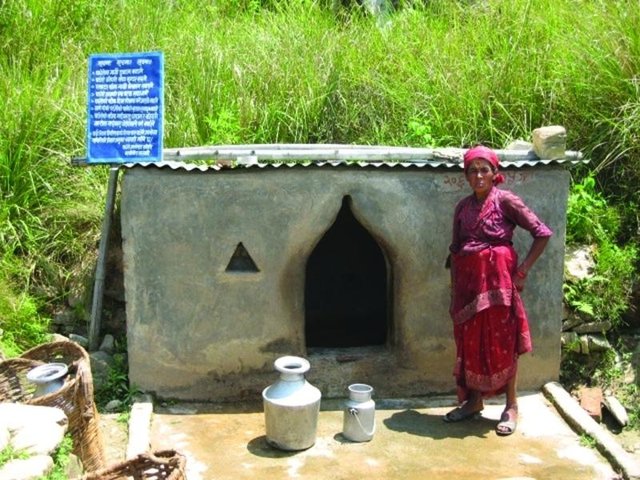
Drinking water quality improvement through conservation measures [尼泊尔]
Structural and vegetative measures to improve the quality of drinking water contaminated due to poor sanitation and seepage
- 编制者: Madhav Dhakal
2. SLM方法的描述
2.1 该方法的简要说明
Working with communities to demonstrate and disseminate methods for improving drinking water quality using structural and vegetative measures
2.2 该方法的详细说明
该方法的详细说明:
Aims / objectives: The People and Resource Dynamics in Mountain Watersheds of the Hindu Kush- Himalayas Project (PARDYP) implemented this approach with 30 drinking water user households at Barbot in the Jhikhu Khola watershed, Kavre Palanchok. The aim was to improve water quality and availability from an open spring source through participatory planning and implementation. The approach first identified local concerns and observed the sanitary situation of the catchment area. Meetings were held jointly with men and women users from different caste groups (Brahmin, Chhetri, Newar and Kami) to discuss the problems and issues and to identify viable solutions. The advantages and disadvantages of the various options were discussed, after which users selected the following three measures to improve the drinking water supply: 1) building a brick-cement walled structure around the main local spring, 2) establishing check dams across nearby rills and gullies, and 3) planting grass around the spring box and tree saplings within the catchment area. The aim was to prevent direct flow of surface water into the spring and reduce contamination and turbidity of the source. Understanding and support was gained by demonstrating the technology and running an awareness campaign.
Role of stakeholders: The project helped form a users committee made up of 11 women and 1 man and encouraged them to plant grass and tree seedlings across the entire catchment. The project regularly measured the quality of the water and shared the results with the users. Rules and regulations were developed to ensure equitable access to the spring and its sustainable use and management. A notice board with do’s and don’ts was placed near the spring. The users held monthly meetings and established a revolving fund for maintaining the structures. Spring users followed the rules and regulations by washing, cleaning, and bathing at separate sources. Livestock grazing was stopped in the nearby area and the area was regularly cleaned. Furthermore, users were encouraged to treat water for drinking using simple methods like SODIS and the low cost Safa filter to avoid microbiological contamination. They were made more aware of water quality, sanitation, and health issues.
2.3 该方法的照片
2.5 采用该方法的国家/地区/地点
国家:
尼泊尔
有关地点的进一步说明:
Kavrepalanchowk district/ Jhikhu Kholawatershed
Map
×2.6 该方法的开始和终止日期
终止年份(若不再采用该方法):
2005
2.7 方法的类型
- 基于项目/方案
2.8 该方法的主要目的/目标
The Approach focused on SLM only
- To explore and demonstrate appropriate water quality improving technologies and methods in a participatory way. - To increase awareness on water quality, water treatment, and health and hygiene. - To share knowledge gained on the water improvement options with farmers and other stakeholders
The SLM Approach addressed the following problems: Weak institutional collaboration to develop technological options for improving drinking water quality and availability and to raise awareness on health and hygiene and waterborne diseases.
2.9 推动或妨碍实施本办法所适用的技术的条件
财务资源和服务的可用性/可得性
- 阻碍
For the maintenance of the implemented technology
Treatment through the SLM Approach: Revolving fund collected by users
机构设置
- 阻碍
Weak institutional collaboration
Treatment through the SLM Approach: User group formed linking local community organisations
法律框架(土地使用权、土地和水使用权)
- 启动
The existing land ownership, land use rights / water rights greatly helped the approach implementation: mostly state owned land and some private land - which helped implementating the technology as there was no conflict.
了解SLM,获得技术支持
- 阻碍
Different water treatment methods
Treatment through the SLM Approach: Awareness of structural and vegetative measures; direct water treatment methods including Safa filter, SODIS, chlorination
3. 相关利益相关者的参与和角色
3.1 该方法涉及的利益相关者及其职责
- 当地土地使用者/当地社区
Land users worked equally divided between men and women
Improvement of drinking water quality and quantity was the major concern of all spring users.
- NGO
- 国家政府(规划者、决策者)
- 国际组织
PARDYP/ICIMOD
如果涉及多个利益相关者,请注明领导机构:
Concept designed by national specialist and implemented jointly with users
3.2 当地土地使用者/当地社区参与该方法的不同阶段
| 当地土地使用者/当地社区的参与 | 指定参与人员并描述活动 | |
|---|---|---|
| 启动/动机 | 互动 | public meetings; meetings organised to identify problems and possible options to overcome them. |
| 计划 | 互动 | public meetings; organised regularly to identify implementing steps, and role and responsibility of different stakeholders in overcoming problems |
| 实施 | 互动 | responsibility for major steps; the user group responsible for implementation and the project for technical support |
| 监测/评估 | 互动 | The quality of the water was measured in each season to monitor the impact of the technology. Detailed progress reports, results, and lessons learned were shared with district level institutions and authorities, water quality reports were shared with spring users at public meetings |
| Research | 被动 | Water quality and availability recorded before and after technology implemented. Studies on access to water and confl icts among users |
3.3 流程图(如可用)
具体说明:
PARDP project donors and implementing partners-- SDC: Swiss Agency for Development and Cooperation IDRC: International Development Research Centre ICIMOD: International Centre for Integrated Mo
作者:
Madhav Dhakal
3.4 有关SLM技术选择的决策
具体说明谁有权决定选择要实施的技术:
- 主要是土地使用者,由SLM专家提供支持
解释:
Users selected three of the potential conservation options.
Decisions on the method of implementing the SLM Technology were made by mainly by land users supported by SLM specialists. The technology and associated measures were not new to the area and the implementing methods were simple and have been practised for a long time. The project initiated the formation of a users committee and the committee conducted the conservation activities.
4. 技术支持、能力建设和知识管理
4.1 能力建设/培训
是否为土地使用者/其他利益相关者提供培训?:
是
明确受训人员:
- 土地使用者
培训形式:
- 公开会议
涵盖的主题:
Concept of conservation measures, and methods of treating contaminated water using SODIS and safa filter.
4.2 咨询服务
土地使用者有权使用咨询服务吗?:
是
指明是否提供了咨询服务:
- 在土地使用者的土地上
说明/注释:
Name of method used for advisory service: Sharing information on water quality status, and raising awareness among users.; Key elements: catchment conservation, health hygiene, water treatment methods; 1) Advisory service was carried out through: projects own extension structure and agents; Extension staff: specifically hired project employees 2) Target groups for extension: land users; Activities: awareness on health hygiene; catchment conservation activities and water treatment methods were shared during meetings.
Advisory service is quite adequate to ensure the continuation of land conservation activities
4.3 机构强化(组织发展)
是否通过这种方法建立或加强了机构?:
- 是,少许
具体说明机构的强化或建立程度:
- 本地
具体说明支持类型:
- 能力建设/培训
提供进一步细节:
Training on water quality treatment provided to local club
4.4 监测和评估
监测和评估是该方法的一部分吗?:
是
注释:
bio-physical aspects were ad hoc monitored through observations; indicators: land use and degradation, sanitary inspection, history of spring, available resources to trap water
technical aspects were regular monitored through measurements; indicators: seasonal water quality and discharge
socio-cultural aspects were ad hoc monitored through observations; indicators: number of spring users, household water requirements, users' issues
no. of land users involved aspects were regular monitored through measurements; indicators: participation in conservation activities
There were few changes in the Approach as a result of monitoring and evaluation: The project consulted with the local women's cooperative to solve a conflict over water quantity and access to spring source.
4.5 研究
研究是该方法的一部分吗?
是
明确话题:
- 社会学
- 技术
提供进一步的细节,并指出是谁做的研究:
Access to drinking water, conflicts at water fetching times, water quality and quantity measurement, and effectiveness of water treatment methods.
Research was carried out on station
5. 融资和外部物质支持
5.1 该方法中SLM组成部分的年度预算
如果不知道准确的年度预算,请给出一个范围:
- < 2,000
注释(例如主要的资助来源/主要捐助者):
Approach costs were met by the following donors: international (SDC, IDRC, ICIMOD): 90.0%; local community / land user(s) (users group): 10.0%
5.3 对特定投入的补贴(包括劳动力)
- 其它
| 其它(具体说明) | 程度如何 | 对补贴做出具体说明 |
|---|---|---|
| Planting materials |
如果土地使用者的劳动力是一项重要的投入,那么是不是:
- 自愿
注释:
In implementing the technology and the approach
5.4 信用
是否根据SLM活动的方法给予信用值?:
是
6. 影响分析和结论性陈述
6.1 方法的影响
该方法是否帮助土地使用者实施和维护SLM技术?:
- 否
- 是,很少
- 是,中等
- 是,支持力度很大
To build awareness on SLM and methods of improving drinking water quality. It also helped users to work in a group.
Did other land users / projects adopt the Approach?
- 否
- 是,很少
- 是,中等
- 是,支持力度很大
Similar approaches are being followed in other communities across Nepal.
6.2 土地使用者实施SLM的主要动机
- 减少工作量
due to reduced water fetching time (or distance).
- 环境意识
Improved heath due to clean water and better sanitation
6.3 方法活动的可持续性
土地使用者能否维持通过该方法实施的措施(无外部支持的情况下)?:
- 是
若是,请说明如何维持:
Users are maintaining the implemented technology and also protecting the other nearby spring sources.
6.4 该方法的长处/优点
| 土地使用者眼中的长处/优势/机会 |
|---|
| Water users committee formed, revolving fund collected, and rules and regulations developed for the sustainable management of the drinking water system (How to sustain/ enhance this strength: Maintain links with local community mobilisation groups for continuous guidance and support for the user group and for the proper use of the revolving fund.) |
| 编制者或其他关键资源人员认为的长处/优势/机会 |
|---|
| Users have become more aware of sanitation issues than before (How to sustain/ enhance this strength: Awareness campaigns should be organized regularly covering more villages.) |
| Users have become more aware of 1) the quality of their drinking water, 2) its impact on their health, 3) water quality improvement options, and 4) the importance of soil and water conservation (How to sustain/ enhance this strength: Water quality testing campaigns should be continued and technical know how about different water quality treatment methods for improved health shared at regular meetings) |
6.5 该方法的弱点/缺点以及克服它们的方法
| 土地使用者认为的弱点/缺点/风险 | 如何克服它们? |
|---|---|
| Water aviallability is still insufficient during dry period (March -May) | Other available nearrer sources should also be used, catchment protection activities should be continued. |
| 编制者或其他关键资源人员认为的弱点/缺点/风险 | 如何克服它们? |
|---|---|
| Conflicts are visible during the dry season due to insufficient quantity of water. | Good coordination among the group members should minimise conflicts- the strong and balanced role of users committee is vital for the equitable sharing of benefits. |
7. 参考和链接
7.1 方法/信息来源
- 实地考察、实地调查
- 与土地使用者的访谈
7.2 参考可用出版物
标题、作者、年份、ISBN:
ICIMOD (2007) Good Practices in Watershed Management, Lessons Learned in the Mid Hills of Nepal. Kathmandu: ICIMOD
可以从哪里获得?成本如何?
ICIMOD
链接和模块
全部展开 全部收起链接

Drinking water quality improvement through conservation measures [尼泊尔]
Structural and vegetative measures to improve the quality of drinking water contaminated due to poor sanitation and seepage
- 编制者: Madhav Dhakal
模块
无模块


